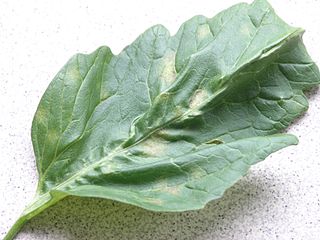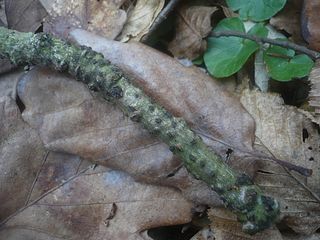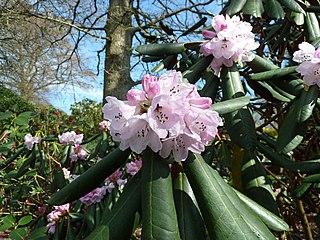
The almond is a species of small tree from the genus Prunus, cultivated worldwide for its seed, a culinary nut. Along with the peach, it is classified in the subgenus Amygdalus, distinguished from the other subgenera by corrugations on the shell (endocarp) surrounding the seed.
Specific replant disease is a malady that manifests itself when susceptible plants such as apples, pears, plums, cherries and roses are placed into soil previously occupied by a related species. The exact causes are not known, but in the first year the new plants will grow poorly. Root systems are weak and may become blackened, and plants may fail to establish properly.

Terminalia catappa is a large tropical tree in the leadwood tree family, Combretaceae, native to Asia, Australia, the Pacific, Madagascar and Seychelles. Common names in English include country almond, Indian almond, Malabar almond, sea almond, tropical almond, beach almond and false kamani.
Jonathan Dallas George Jones is a senior scientist at the Sainsbury Laboratory and a professor at the University of East Anglia using molecular and genetic approaches to study disease resistance in plants.
Phytophthora drechsleri is a plant pathogen with many hosts.
Podosphaera tridactyla is a plant pathogen infecting almonds.
Podosphaera tridactyla var. tridactyla is a plant pathogen infecting almond.
Rhizopus circinans is a plant pathogen infecting almond, apricot and peach.

Taphrina deformans is a fungus and plant pathogen, and a causal agent[s] of peach leaf curl. Peach trees infected with T. deformans will experience leaf puckering and distortion, acquiring a characteristic downward and inward curl. Leaves will also undergo chlorosis, turning a pale green or yellow, and later show a red or purple tint. Fruit can either drop prematurely or show surface distortions. Severe infection can also produce lesions on the flowers. The host tree will experience defoliation if the leaves are badly diseased. If a seedling is severely infected, it may die. Almond trees display similar symptoms.

Passalora fulva is a fungal plant pathogen that causes tomato leaf mold.

Valsaria insitiva is a plant pathogen, that causes perennial canker in apples and almonds.
Clusia polystigma is a species of flowering plant in the family Clusiaceae. It is found only in Ecuador. Its natural habitat is subtropical or tropical moist lowland forest.
Potato virus X (PVX) is a plant pathogenic virus of the family Alphaflexiviridae and the order Tymovirales.
The parasexual cycle, a process restricted to fungi and single-celled organisms, is a nonsexual mechanism of parasexuality for transferring genetic material without meiosis or the development of sexual structures. It was first described by Italian geneticist Guido Pontecorvo in 1956 during studies on Aspergillus nidulans. A parasexual cycle is initiated by the fusion of hyphae (anastomosis) during which nuclei and other cytoplasmic components occupy the same cell. Fusion of the unlike nuclei in the cell of the heterokaryon results in formation of a diploid nucleus (karyogamy), which is believed to be unstable and can produce segregants by recombination involving mitotic crossing-over and haploidization. Mitotic crossing-over can lead to the exchange of genes on chromosomes; while haploidization probably involves mitotic nondisjunctions which randomly reassort the chromosomes and result in the production of aneuploid and haploid cells. Like a sexual cycle, parasexuality gives the species the opportunity to recombine the genome and produce new genotypes in their offspring. Unlike a sexual cycle, the process lacks coordination and is exclusively mitotic.
In taxonomy, Rhodothalassium is a genus of the Rhodobacteraceae. Up to now there is only one species of this genus known.
Fulvous is a colour, sometimes described as dull orange, brownish-yellow or tawny; it can also be likened to a variation of buff, beige or butterscotch. As an adjective it is used in the names of many species of birds, and occasionally other animals, to describe their appearance. It is also used as in mycology to describe fungi with greater colour specificity, specifically the pigmentation of the surface cuticle, the broken flesh and the spores en masse.

Rhododendron fulvum is a species of flowering plant in the heath family Ericaceae, native to northern Myanmar and China. In China, it is found in southwest Sichuan, southeast Xizang, and western Yunnan. It grows at altitudes of 2,700–4,400 m (8,900–14,400 ft). It is an evergreen shrub or small tree growing to 2–8 m (6.6–26.2 ft) in height, with leathery leaves that are oblanceolate to oblong-lanceolate or obovate, 8–20 by 3–7.5 cm in size. The undersides are felted with a striking cinnamon colour. The flowers, borne in trusses in spring, are loosely bell-shaped, pale rose pink, with a crimson basal blotch and sometimes red spots.

Nicholas José Talbot FRS FRSB is Group Leader and Executive Director at The Sainsbury Laboratory in Norwich.
Cladosporium fulvum is an Ascomycete called Passalora fulva, a non-obligate pathogen that causes the disease on tomatoes known as the tomato leaf mold. P. fulva only attacks tomato plants, especially the foliage, and it is a common disease in greenhouses, but can also occur in the field. The pathogen is likely to grow in humid and cool conditions. In greenhouses, this disease causes big problems during the fall, in the early winter and spring, due to the high relative humidity of air and the temperature, that are propitious for the leaf mold development. This disease was first described in the North Carolina, by Mordecai Cubitt Cooke (1883), on cultivated tomato, although it is originally from South and Central America. The causal fungus of tomato leaf mold may also be referred to as Cladosporium fulvum, a former name.

Rosemary E. Bradshaw is a New Zealand mycologist, as of 2019 full professor of genetics at the Massey University.







